Email campaign success is one of the most requested topics among our customers. For this reason, we brought together a mix of Market Location colleagues with deep experience on the topic to compile our top advice.
Email campaigns are a powerful tool for businesses looking to connect with potential customers and promote their products or services. With our extensive experience in email campaigns, we wanted to share the most effective tips for improving success.
Set Your Goals
First and foremost, it’s crucial to have a clear objective in mind for your email campaign. The objective should be a goal communicated across the organisation and shared with your email marketing provider or internal communication departments. Our customers often want to increase sales, generate leads, and build brand awareness. One customer had a clear objective to increase marketing-generated leads by 20% within a month. They achieved this by segmenting their email list and sending targeted email campaigns. By having a clear objective, you can also measure the success of your campaign and make any necessary adjustments.
Segment Your Data
Quality data is the backbone of all successful email campaigns. At Market Location, we provide our customers with a database of UK businesses most likely interested in their products or services. The data allows our customers to create highly targeted and personalised campaigns that deliver results. One of our customers, who sells eco-friendly products, recently used our data to segment their email list based on the recipient’s interest in sustainable products and saw a 25% increase in sales from their email campaigns.
But it’s not just about the data; it’s also about how you use it. Segmenting your audience based on their interests and behaviours is critical to creating effective campaigns. Our customers often segment their audience based on demographics, purchase history, and engagement with previous campaigns. A recent customer segmented their email list based on purchase history and then used our data to send a personalised email campaign to look-a-like companies offering similar products, which led to a 15% increase in purchases.
Consistent Cadence
Repetition is also a critical factor in the success of email campaigns. You can improve your brand reputation and lead volumes by sending emails regularly. At Market Location, we recommend our customers send at least one email per month to stay top of mind with their audience. Newsletters are a great way to communicate with your prospects without bombarding them with offers; a recent customer who sends a monthly newsletter to their email list saw a 20% increase in website traffic and a 10% increase in sales.
Success Measurement
Measuring the success of your email campaigns is essential. We use tracking links, landing pages and analytics tools to measure open rates, click-through rates, and conversions. These techniques allow our customers to view which campaigns deliver results and which need to be adjusted. Even if a campaign looks like it’s failing to deliver the results that you’re looking for, a minor tweak could turn that around. One customer used links to measure the success of their email campaign and found that their open rate was low, so they changed the subject line and saw a 25% increase in open rate.
Many clients attribute their marketing campaigns to specific channels, as it is essential to understand which channels drive the most conversions and revenue. There are several methods to attribute marketing campaigns to channels:
- UTM parameters: UTM (Urchin Tracking Module) parameters are tags that can be added to the end of a URL. These parameters allow you to track the source, medium, and campaign name of the traffic that comes to your website. You can then use this information to attribute conversions to specific channels.
- Tracking pixels: These are small pieces of code you can add to your website. When someone visits your website, the tracking pixel sends data back to your analytics platform, allowing you to track the traffic source. Tracking emails in this way can help you attribute conversions to specific channels.
- Call tracking: Call tracking involves using a unique phone number for each marketing campaign and then using call tracking software to track which campaigns drive the most phone calls. Attribute conversions to specific channels can be achieved with this approach.
- Multi-touch attribution: These models consider a customer’s different touchpoints with your brand before converting. It can attribute conversions across multiple channels by assigning credit to each touchpoint. For example, which companies have been emailed or completed a landing page enquiry and subsequently bought?
- Surveys can be used to ask customers how they first heard about your brand or which channels were most important in their purchase decision. Collecting these answers can provide valuable insights into how different marketing channels drive conversions.
It’s important to note that different attribution methodologies may give different results, so it’s good to test multiple options and choose the one that best aligns with your business objectives. In addition, it’s essential to clearly understand the customer journey and touchpoints to attribute conversions to the proper channels.
The length of campaigns also plays a role in their success. At Market Location, we advise our customers to evaluate success early on and adjust as needed; this process can take many months of trial and error.
Automated Nurture Emails
Nurturing campaigns can also be more effective, allowing you to build relationships with your audience over time. Some customers often use a series of emails that provide valuable information or resources, gradually moving the recipient towards a sale. It is particularly successful when the audience is large, and the client has an established creative process. For example, a job board sent a series of cold communications, not all sales related, but joined up the follow-up email to the link a recipient had clicked; this led to a 70% increase in sales in 2022.
Multi-channel Approach
Finally, using multiple channels can also help improve the success of email campaigns. For example, combining email with PPC and TV advertising can increase brand awareness and drive more traffic to your website. A telecommunication customer who sells equipment found that an email sent the day after their advert appeared in the Champions League TV advertising break generated the highest number of leads.
Lead Follow Up
We are often asked how and how quickly a sales team should follow up on a lead, so our discussion covered the points below.
If an email campaign aims to generate leads, the sales team needs to follow up quickly and use a clear and concise script to convert those leads into customers effectively.
The first step is to have a system for tracking and managing leads. A CRM system can store contact information, track interactions, and set reminders for follow-up.
The length of time that you can take to follow up on a lead depends on the product or service you are offering. If you’re offering insurance, as an example, if someone is interested in your email, you will likely need to follow up on the same day to ensure you reach them before they’ve decided. However, if your product or service is less time-dependent, you can take up to 48 hours to follow up on the lead. Follow-up can be done through a quick phone call or an email to introduce yourself, thank the contact for their interest, and set up a time for a more in-depth conversation.
It’s also important to personalise the follow-up, using information from the lead’s email or website interactions to tailor the message and make it more relevant.
After the initial follow-up, it’s essential to continue to nurture the lead through a series of touchpoints, such as email, phone calls, and even direct mail. This will help keep the lead engaged and interested and increase the chances of converting them into customers.
In summary, following up quickly and effectively is critical to converting leads generated by email campaigns into customers. You will also need a system for tracking and managing leads, personalising the follow-up, nurturing the lead through a series of touchpoints, and setting a specific follow-up timeline.

